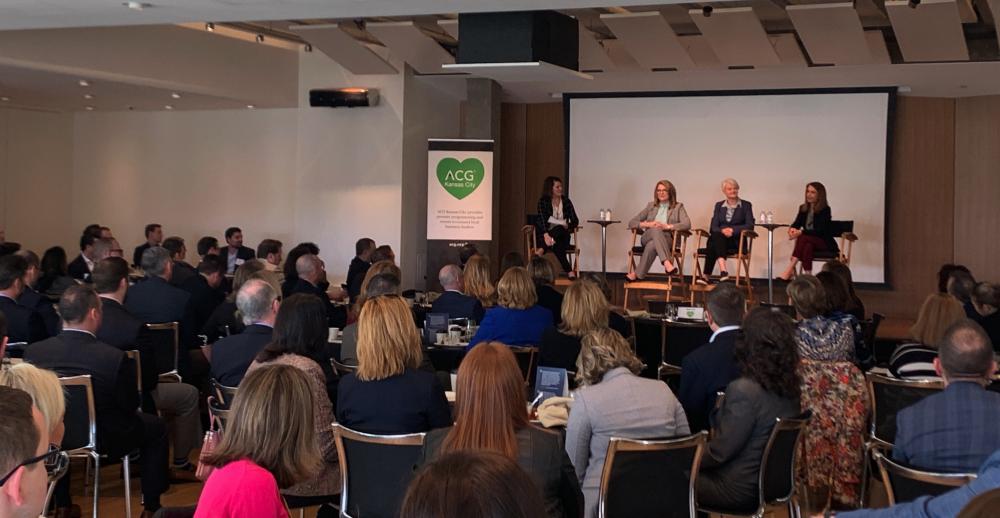
Work hard with integrity and successfully balance customer needs and wants with the company’s balance sheet.

Three Kansas City-based businesses of varying sizes and industries might not seem to have anything in common when it comes to how they operate, design their futures or work with employees. But an hour-long panel discussion with three of their leaders proved that the basis for success is really the same: Work hard with integrity and successfully balance customer needs and wants with the company’s balance sheet.
The recent ACG Kansas City breakfast meeting held on March 6, “Corporate Growth Strategies: A Panel Discussion,” featured Stacie Prosser, market president and publisher of the Kansas City Business Journal, moderating a panel made up of Victoria Barnard, present of Foot Traffic USA and director and chairman of the Compensation Committee for Just Born Quality Confections; Heather Humphrey, senior vice president, general counsel and corporate secretary of Evergy; and, Ora Reynolds, president and CEO of Hunt Midwest Enterprises, Inc.
How are the companies continuing their growth?
“For us, there are two ways,” Humphrey said. “We either do it through M&A or by growing our organization. We do both.”
“And you can’t stop,” she continued. “A merger is like a snake eating a goat – there’s a lot there, especially in a very regulated, very public industry. But you don’t stop doing business; you keep going.”
For Evergy, its growth that hasn’t come from its merger activity has come from its own Evergy Venture Capital arm.
“We’ve found that it’s better for us to stay with our core strength. We can do things outside of it, but we really stay at our core – we can’t lose focus.”
Reynolds talked about the ways Hunt Midwest grows while always following its core values.
“REF is what we use,” she said. “Reputation – doing what you say you will; Expertise – we are real estate developers. And, financial capacity to get through projects.”
Reynolds also cited the company’s strategic look at growth – to fill in gaps when necessary, but not to grow just for growth’s sake.
At Foot Traffic, Barnard and her team are constantly swiveling because that’s the way the fashion industry works, she said. But they do follow a set of ideas when it comes to evaluating opportunities.
“Is the opportunity enough and will the profit be enough? Can we use the distribution channels we already know to harness the growth? Does it leverage our sourcing abilities? And, does it build on our brand in a significant way?” Barnard said.
Growth doesn’t come without its challenges, however. One of Foot Traffic’s current challenges is keeping happy a small, but extremely devoted, group of consumers who love the company’s bamboo socks.
“We are trying to figure out how to grow that, too,” Barnard said. “It’s a competitive category on Amazon. It’s a great product - a little outside our usual novelty socks – and we are trying to harness it for growth.”
In Humphrey’s case, Evergy is always trying to balance an increase in demand while hedging for earnings that shareholders demand.
“Our shareholders don’t expect us to take a lot of risks outside of our wheelhouse,” Humphrey said. “Figuring out our sweet spot has been critical between sticking and straying.”
Hunt Midwest has found itself having to grow geographically, while staying within its business. Having been Kansas City’s only real estate business for a long time, growth meant moving outside of the metro area.
“We’ve been in Texas, south Florida, and we are getting ready into Louisville,” she said.
As much as there are similarities in the way these companies do business and approach growth, there are some obvious differences based on their size and industries.
Prior to joining Foot Traffic, which her husband founded, Barnard had a long career at Hallmark. She saw firsthand the advantages and disadvantages of growth in a large corporate setting. Obviously, Hallmark’s vast resources allow it to grow in bigger ways than a company such as Foot Traffic.
“Hallmark has brand equity. It allowed for the company to buy Odyssey Channel, which became the Hallmark Channel, which is the fifth most watched channel in prime time,” she said. “At Foot Traffic, though, because we are small, we can be faster to market with products. We don’t have the same overhead; our brand risk is lower; our decision-making is faster. Each has its strengths and weaknesses.”
What’s next? The coming year promises to be filled with an array of opportunities and challenges. Coronavirus is certainly one that has already affected and will continue to affect Foot Traffic as many of its relationships are built through Asia. Already, the company has cancelled plans to travel to the area to discuss fall designs. But, Barnard says she and the company’s leadership also know that being positioned for the downtimes is what helps businesses stay on top.
Reynolds sees economic downturns as positive for Hunt Midwest as they proved during the Great Recession, when the company expanded into senior housing, infrastructure and self-storage projects.
“If we’d have stopped at the downturn, we’d have missed a lot,” Reynolds said.

Register by January 14 to maximize value, elevate your experience, and get a head start connecting with 3,200+ dealmakers and executives.
